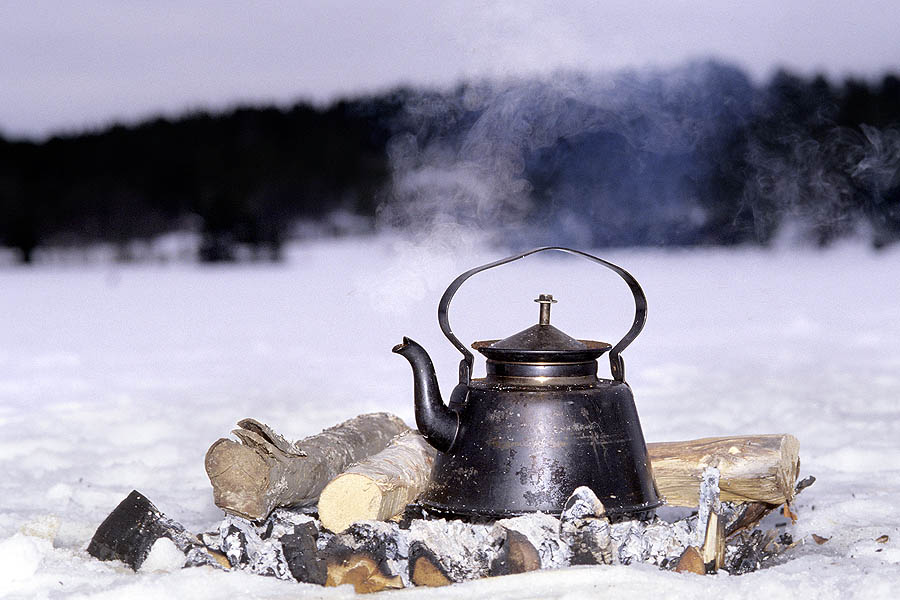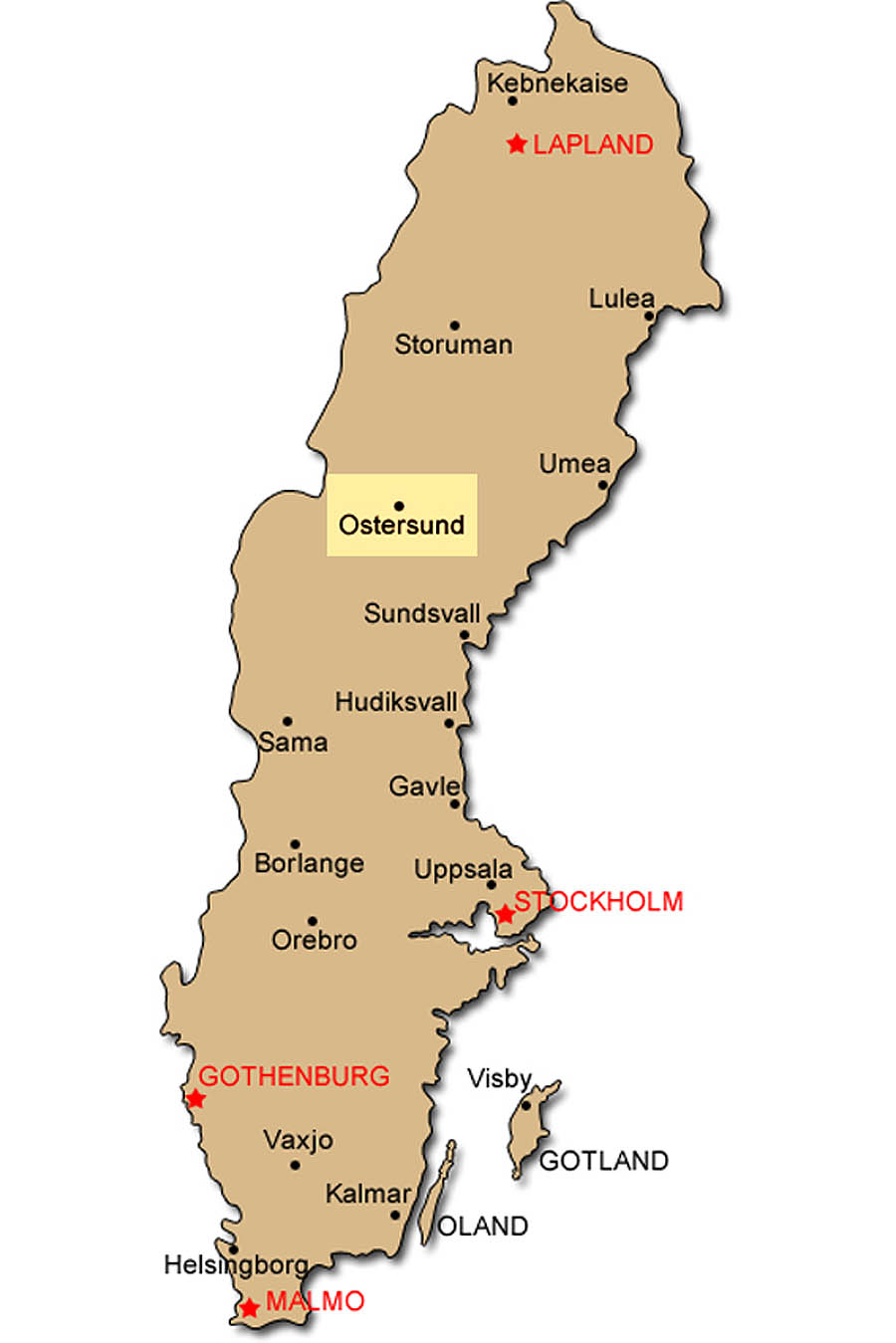 Jämtland is a big mid-Swedish county reaching from the mountains bordering Norway right out to the Baltic Sea. In and around the city of Östersund, and through much of Jämtland, you find the huge water system of River Indalsälven. Lake Storsjön and the other big lakes in the area are "fuelled" by this wide-reaching river. Jämtland prides itself of having Sweden's last true wilderness with a sublimely rich nature and varied wildlife, where you stand a good chance of meeting moose, reindeer, bear, lynx and much, much more…
Jämtland is a big mid-Swedish county reaching from the mountains bordering Norway right out to the Baltic Sea. In and around the city of Östersund, and through much of Jämtland, you find the huge water system of River Indalsälven. Lake Storsjön and the other big lakes in the area are "fuelled" by this wide-reaching river. Jämtland prides itself of having Sweden's last true wilderness with a sublimely rich nature and varied wildlife, where you stand a good chance of meeting moose, reindeer, bear, lynx and much, much more…
The fishing in this area is something to experience too – so much so, that I have been there on more than 10 fishing trips so far, and with 5 more trips planned for this year.
SUMMER FISHING
When planning the summer fishing, I have had Jämtland as my first priority for several years now. The good friends, wonderful fishing, nature and wildlife has kept me coming back, and the pursuit of bigger and more beautiful specimens has captured me – especially after having seen, hooked and lost them.
I know for a fact that Jämtland can produce fantastic specimens, because I am fortunate to be friends with some of Jämtland's greatest anglers, Anders Dahlén and Lars-Göran Nilsson, and they have shown me photos and told me stories, which ensnares me even more. They have superior knowledge of the nature, the waters, fishing techniques and species – a knowledge you can only build through a lifetime of exploring the outdoor elements and a love for the nature and fishing.
We fish for many species, when we meet, and I will try and describe fishing for some of the most interesting of them, as I have experienced it:
Grayling (Thymallus thymallus)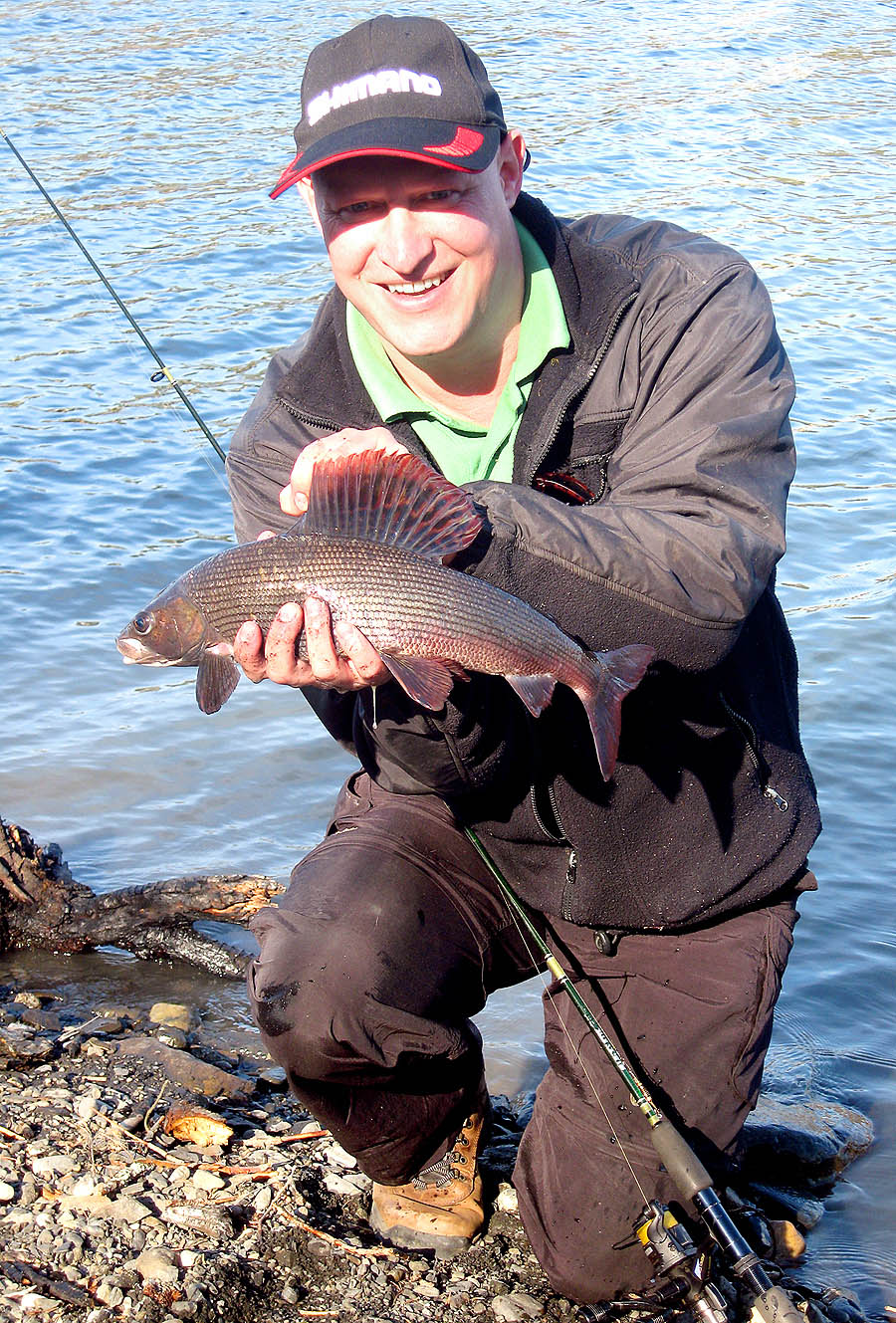
You can catch grayling just about anywhere in the River Indalsälven system – from the doorstep of Lars-Görans house in Lake Storsjön to Sweden’s second best grayling water, a stretch on River Indalsälven called Kvissle…
Kvissle is one of our ultimate favourites. Kvissle is strangely enough not as crowded as you would think, and my friends and I have spent many hours wading, fly fishing and spinning there, and caught a healthy number of grayling and the occasional brown trout. We know from our friends up there that there are big grayling in Kvissle – I haven't caught bigger than 0.6 kg grayling there myself, but I have definitely not lost faith.
Because Jämtland is so far north, the summer nights are very short and bright, and the sunset seems to go on forever. Last year we experienced a magical night in Kvissle, when it had just rained heavily - the clouds cleared, leaving cool air above warm water resulting in heavy mist coming off the water. After a while the mist broke up in many drifting parts and the moon rose to reveal scenery taken right out of a fairytale. As if on cue the grayling started topping, and we waded out amongst hundreds of them. We caught more than 10 fish each in an hour, though Anders' fly rod was bent every time I looked; but the best part of it was the sublime atmosphere, which I have rarely experienced before.
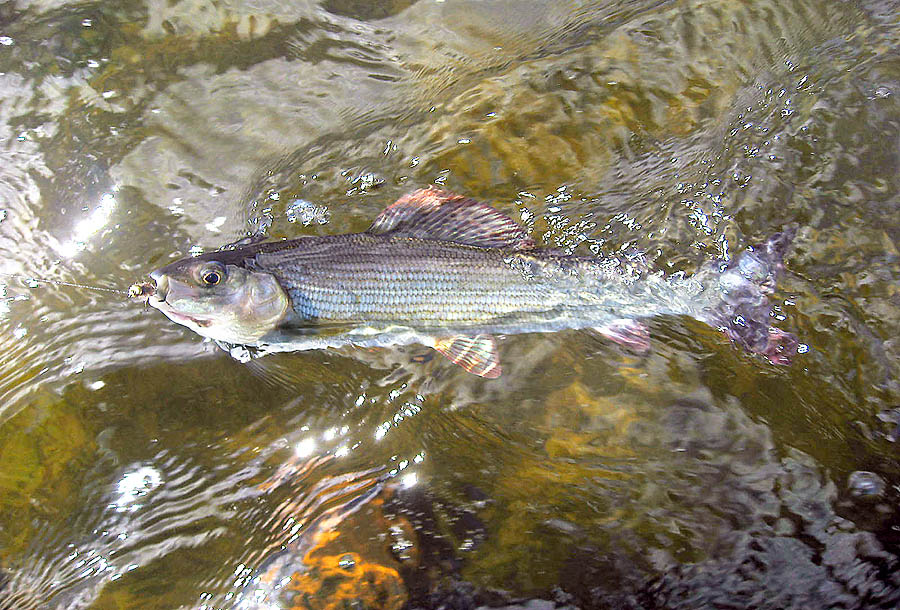 In other areas of River Indalsälven we have come across bigger specimens, and in some of Anders' favourite spots he has caught an enviable number of grayling between 1 and 1½ kg, and witnessed trophy grayling as big as 2 kg.
In other areas of River Indalsälven we have come across bigger specimens, and in some of Anders' favourite spots he has caught an enviable number of grayling between 1 and 1½ kg, and witnessed trophy grayling as big as 2 kg.
It is not difficult to catch grayling in Jämtland. When Flemming and I went there the first time, we caught many on both spinner and fly, and trust me we didn't have to work too hard for it. To catch the big specimens takes great effort, of course.
We have had very good results on brass-head nymphs and small spinners. Where it is deep we use small spinners with a lead weight in front.
Canadian Lake Char (Salvelinus namaycush)
Our friend, Lars-Göran, is the "local hero" when it comes to trolling for Canadian lake char. Lars-Göran has caught the second biggest of this species in Sweden, an honour he deserves fully. I have fished several summers with him for these pretty fish, and I can't wait to do it again.
The trolling has become more and more popular in Östersund, where you have enormous lakes to explore. Trolling for Canadian lake char in Lake Storsjön and the other big lakes in the area is usually best in July and August, when the surface water is warmest. The fishing is done both with traditional downriggers and the super effective planner-boards. The big planner-boards are used for baits running in the surface down to about 5 metres, and this is the optimal depth for hunting Canadian lake char there.
The local record is Lars-Göran's fish, which weighed 8½ kg, but anglers have lost fish to well above 10 kg, and several have been caught in nets to 14 kg a couple of years ago.
 Lake Trout (Salmo trutta lacustris)
Lake Trout (Salmo trutta lacustris)
We have caught many lake trout when trolling the lakes in the Östersund area – and there certainly is a healthy population of them in all the river/lake the system. They are also caught in the rivers (not brown trout), because River Indalsälven is so big, and because they travel up and down to spawn. These lake trout are easily distinguished from brown trout even though they are sub species of the same fish (Salmo trutta) – the lake trout are caught to 10 kg, and the local record is 14 kg.
The big lake trout we like to catch in the rivers, where the flow is fast, and the best technique is a heavy spoon slowly retrieved just over the bottom.
Besides the fish I have described we also summer fish for pike, brown trout, brook trout, splake (char hybrid), ide, perch…
WINTER FISHING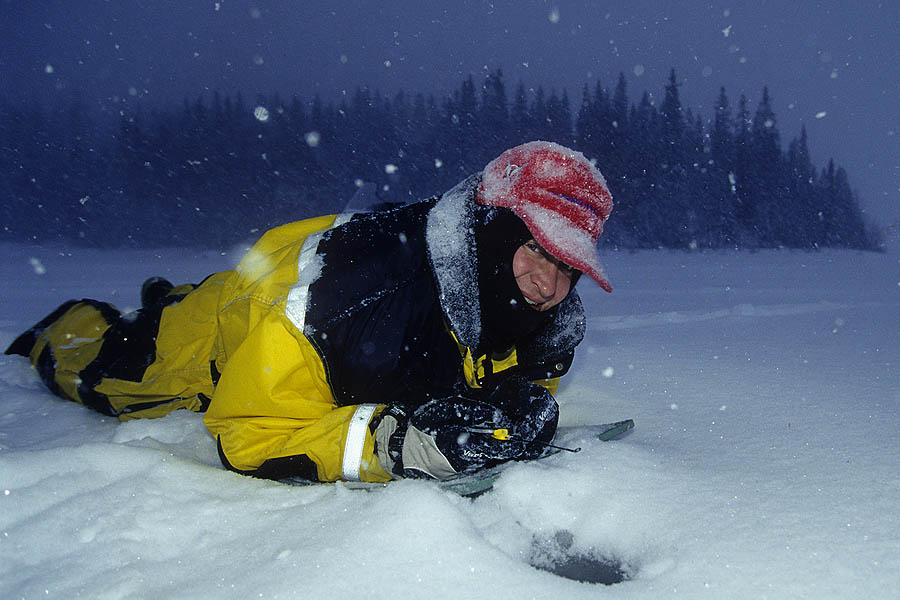 Unlike in most parts of the world, you have very interesting fishing in Jämtland all seasons. I thought that summer time would be the busiest in Jämtland, when tourists try their luck with the excellent grayling fishing, but I was clearly off the mark. Winter is actually the busiest time of the year, because the locals themselves bring the whole family out (and I mean the whole family, women and children too) on the ice, in wind and frost, to spend the few daylight hours driving snow scooters and dog-sledges, even their cars, out on the ice of the lakes and rivers, drilling holes in the ice to catch frosty fish. But why do they like it so much?
Unlike in most parts of the world, you have very interesting fishing in Jämtland all seasons. I thought that summer time would be the busiest in Jämtland, when tourists try their luck with the excellent grayling fishing, but I was clearly off the mark. Winter is actually the busiest time of the year, because the locals themselves bring the whole family out (and I mean the whole family, women and children too) on the ice, in wind and frost, to spend the few daylight hours driving snow scooters and dog-sledges, even their cars, out on the ice of the lakes and rivers, drilling holes in the ice to catch frosty fish. But why do they like it so much?
Well, I'm totally fascinated with this type of fishing now, as well!
For my part it's the sensation of being outside in the worst of weather without being cold, lying in deep snow watching for fish in the ice-hole, brewing a cup of coffee and frying sandwiches on the sledge-grill we bring with us, the ultimate freedom in driving a snow scooter in the mountains, where you often meet moose, reindeer, rock ptarmigan and other interesting wildlife. Need I say more?
Here are a couple of the most popular fish we catch in winter:
 Landlocked Arctic Char (Salvelinus alpinus)
Landlocked Arctic Char (Salvelinus alpinus)
The arctic char is a true "winner" when it comes to ice fishing – it is a very beautiful fish, hard fighting, good tasting, it's most often caught to weights of ½-2 kg and is prolific in the Norwegian and Swedish mountains.
In the beginning of winter the arctic char is found right under the ice and down to a couple of yards underneath, but throughout the winter it moves to deeper and deeper water.
We usually fish for them with a fairly big spoon as an attractor, and below the spoon you have a hook length of 10-15 cm with either a nymph or a Myschka (the Myschka is a sort of mini-jig without the rubber body). It is common to use a single maggot on the hook as well, which I think is an obvious advantage.
Houting (Coregonus spp.)
For most of the winter season it is difficult to target the houting, but you will often get them as a side-catch. They are both pretty and tasty fish, and then you have a good chance of landing fish between ½ and 3 kg. However, you can actually target them in early December, when they migrate to shallow water to spawn. If you know the houting waters it is normally up to yourself how many you want to catch at this time.
The houting are easiest to catch at dawn and dusk, and preferably an hour on each side. In darkness we use luminous tackle to attract them, that being fluorescent or phosphorescent strips on the spoon or on the line, or a luminous Myschka, or even all three…
You fish with a spoon as for arctic char, but it is recommendable to use smaller spoons, because the houting are easily spooked. To optimize your chances, it is a good idea to use two hook lengths, one above the spoon and one below – and again maggots can make a huge difference.
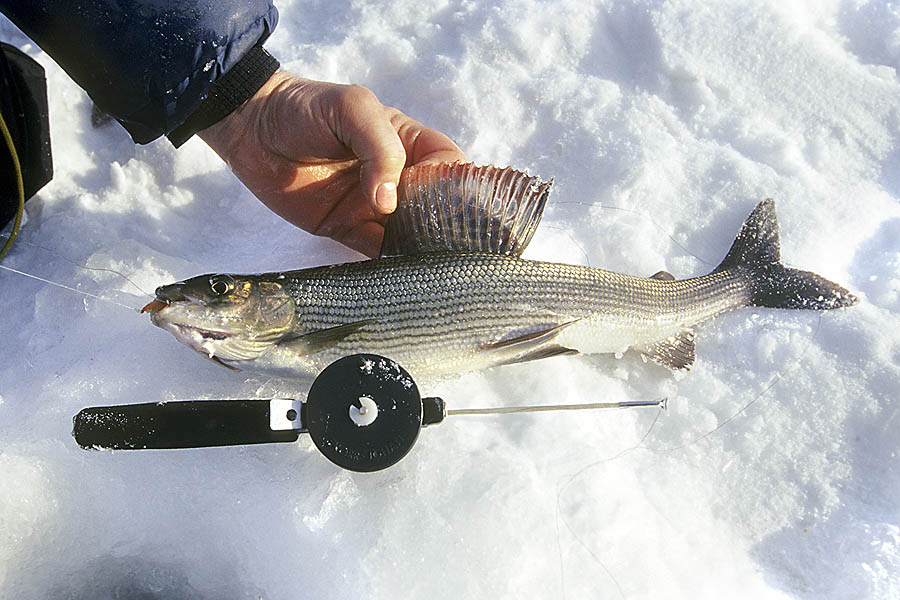 Grayling (Thymallus thymallus)
Grayling (Thymallus thymallus)
Winter fishing for grayling is best in the spring. Most years, in Jämtland, there is thick ice in the month of April and sometimes even into May. In April you have longer days and generally good weather, so it's not uncommon to see people ice fishing in t-shirts.
The grayling can then be caught both ice fishing, and spinning and fly fishing where the rivers are open. We ice fish for them on the ice of the rivers, even the partly open rivers. It's a bit eerie to walk on the ice beside of a fast flowing river, but the ice is incredibly strong and as thick as 1½ metres.
What really seemed strange was the fact that we were advised to fish on this thick ice with only about 20 cm of water underneath, but that is apparently how it is best done. You sit or lie on the ice (usually on a bedroll or reindeer skin) and look through the hole, waiting for a bite – and the bite comes lightning fast. Unlike the char and houting, which often study the bait intensively, the grayling does seldom show itself before attacking. Now that's a helluva wakeup call, when that happens.
The rig-setup for grayling is very simple – just a Myschka with a couple of maggots will do the trick.
Besides these species we winter fish for lake trout, brown trout, perch, pike, burbot…
